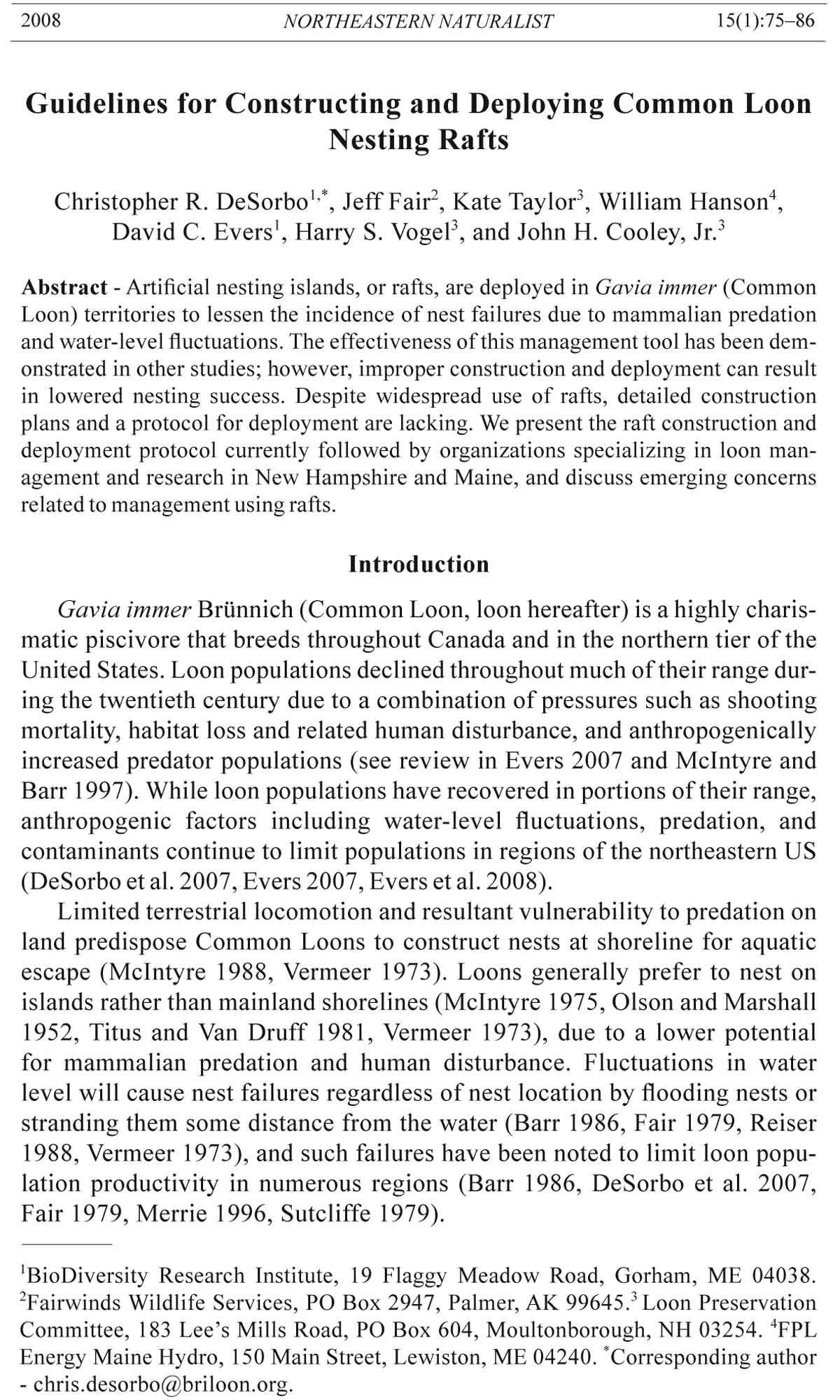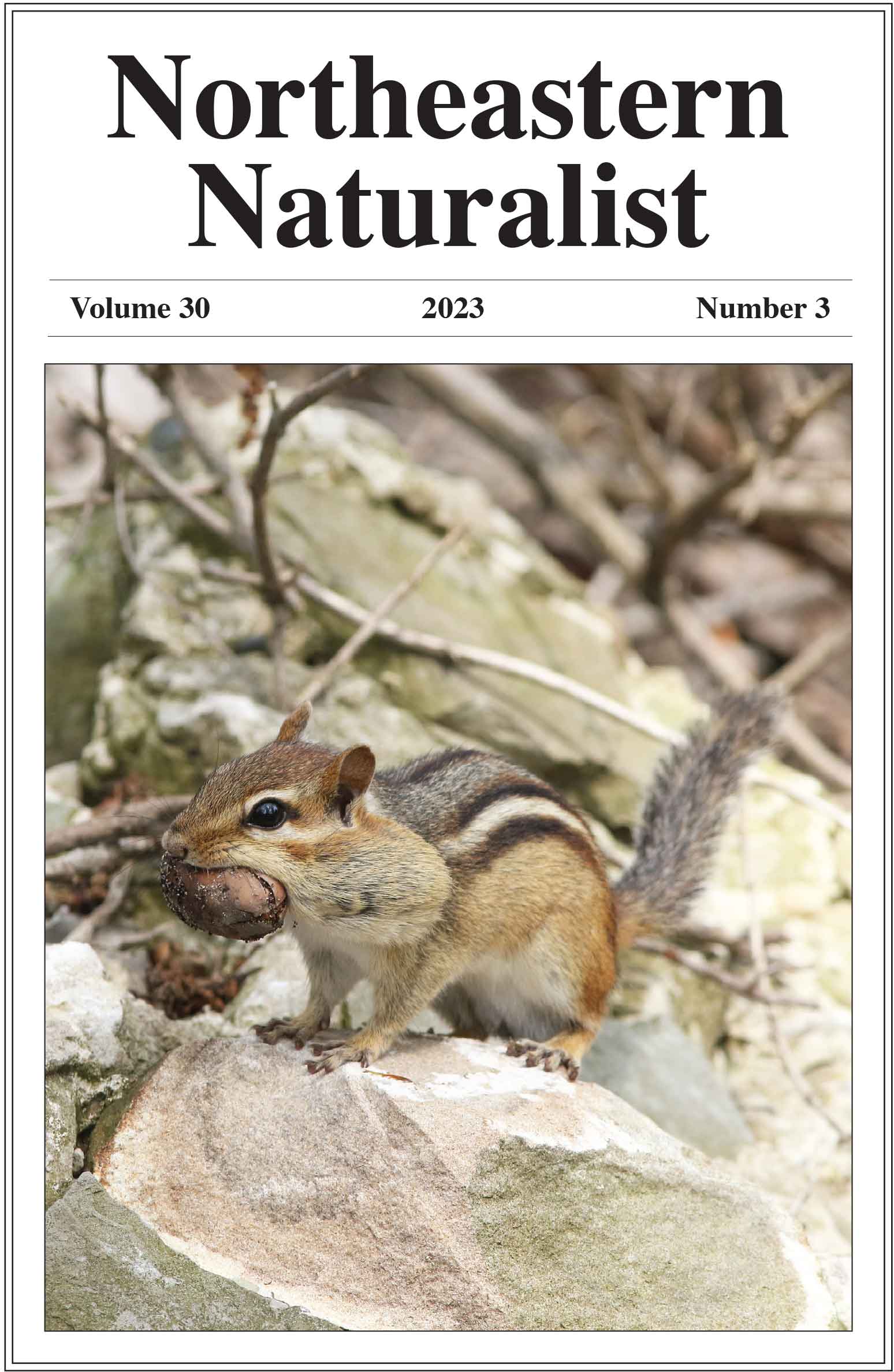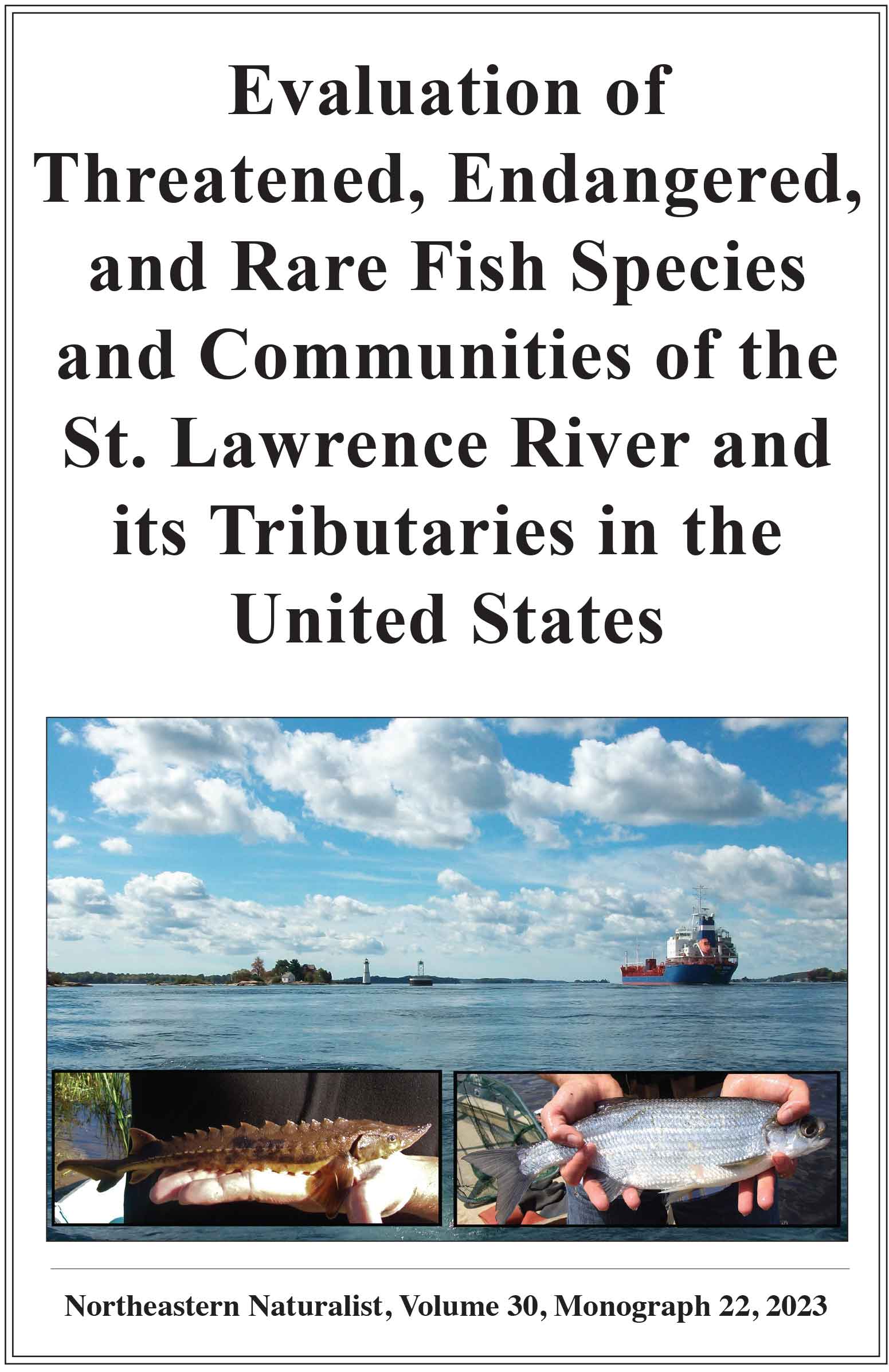Guidelines for Constructing and Deploying Common Loon
Nesting Rafts
Christopher R. DeSorbo, Jeff Fair, Kate Taylor, William Hanson,
David C. Evers, Harry S. Vogel, and John H. Cooley, Jr.
Northeastern Naturalist, Volume 15, Issue 1 (2008): 75–86
Full-text pdf (Accessible only to subscribers.To subscribe click here.)

Access Journal Content
Open access browsing of table of contents and abstract pages. Full text pdfs available for download for subscribers.
Current Issue: Vol. 30 (3)

Check out NENA's latest Monograph:
Monograph 22









2008 NORTHEASTERN NATURALIST 15(1):75–86
Guidelines for Constructing and Deploying Common Loon
Nesting Rafts
Christopher R. DeSorbo1,*, Jeff Fair2, Kate Taylor3, William Hanson4,
David C. Evers1, Harry S. Vogel3, and John H. Cooley, Jr.3
Abstract - Artificial nesting islands, or rafts, are deployed in Gavia immer (Common
Loon) territories to lessen the incidence of nest failures due to mammalian predation
and water-level fluctuations. The effectiveness of this management tool has been demonstrated
in other studies; however, improper construction and deployment can result
in lowered nesting success. Despite widespread use of rafts, detailed construction
plans and a protocol for deployment are lacking. We present the raft construction and
deployment protocol currently followed by organizations specializing in loon management
and research in New Hampshire and Maine, and discuss emerging concerns
related to management using rafts.
Introduction
Gavia immer Brünnich (Common Loon, loon hereafter) is a highly charismatic
piscivore that breeds throughout Canada and in the northern tier of the
United States. Loon populations declined throughout much of their range during
the twentieth century due to a combination of pressures such as shooting
mortality, habitat loss and related human disturbance, and anthropogenically
increased predator populations (see review in Evers 2007 and McIntyre and
Barr 1997). While loon populations have recovered in portions of their range,
anthropogenic factors including water-level fluctuations, predation, and
contaminants continue to limit populations in regions of the northeastern US
(DeSorbo et al. 2007, Evers 2007, Evers et al. 2008).
Limited terrestrial locomotion and resultant vulnerability to predation on
land predispose Common Loons to construct nests at shoreline for aquatic
escape (McIntyre 1988, Vermeer 1973). Loons generally prefer to nest on
islands rather than mainland shorelines (McIntyre 1975, Olson and Marshall
1952, Titus and Van Druff 1981, Vermeer 1973), due to a lower potential
for mammalian predation and human disturbance. Fluctuations in water
level will cause nest failures regardless of nest location by flooding nests or
stranding them some distance from the water (Barr 1986, Fair 1979, Reiser
1988, Vermeer 1973), and such failures have been noted to limit loon population
productivity in numerous regions (Barr 1986, DeSorbo et al. 2007,
Fair 1979, Merrie 1996, Sutcliffe 1979).
1BioDiversity Research Institute, 19 Flaggy Meadow Road, Gorham, ME 04038.
2Fairwinds Wildlife Services, PO Box 2947, Palmer, AK 99645.3 Loon Preservation
Committee, 183 Lee’s Mills Road, PO Box 604, Moultonborough, NH 03254. 4FPL
Energy Maine Hydro, 150 Main Street, Lewiston, ME 04240. *Corresponding author
- chris.desorbo@briloon.org.
76 Northeastern Naturalist Vol. 15, No. 1
In the late 1960s, Mathisen (1969) noted that loons would nest on sedge
mats intended for waterfowl. Within the next decade, biologists began placing
sedge mats and cedar log rafts within loon territories, and loons readily nested
and produced young from them (McIntyre and Mathisen 1977, Sutcliffe 1979).
Conservation organizations subsequently increased raft deployments on New
England lakes and partnered with industry to manage loon populations on hydroelectric
reservoirs, where nest failures due to water-level fluctuation are
common. Success of raft management programs on hydroelectric reservoirs
led to their incorporation into hydroelectric project licenses overseen by the
Federal Energy Regulatory Commission (FERC) (DeSorbo et al. 2007, Fair
1979, Fair and Poirier 1993). Similar management programs involving rafts
have also been implemented on hydroelectric reservoirs and recreational fishing
lakes in Scotland for Gavia arctica Linnaeus (Arctic Loon) and Gavia
stellata Pontoppidan (Red-throated Loon) (Merrie 1979, 1996). Rafts have
become a standard management tool used to varying degrees by conservation
organizations, industry, and state and federal wildlife agencies on natural and
impounded lakes throughout the northeastern (i.e., ME [FPL Energy Maine
Hydro, BioDiversity Research Institute, Loon Preservation Committee], NH
[Loon Preservation Committee, FPL Energy Maine Hydro], MA [Massachusetts
Division of Recreation and Conservation] ,VT [Vermont Loon Recovery
Project, Vermont Institute of Natural Science], NY [Wildlife Conservation
Society]), midwestern (i.e., MI [Michigan Loon Preservation Association],
WI [Wisconsin Department of Natural Resources, Project, Sigurd Olson Institute],
MN [Minnesota Division of Ecological Services ), and northwestern
(WA [Loon Lake Association, Washington Department of Fish and Wildlife,
US Forest Service]) US. Groups managing loon populations in the northeastern
US (ME, NH, VT, NY) maintain generally similar raft construction and
deployment protocols via discussion at annual meetings of the Northeastern
Loon Working Group (www.BRILoon.org).
It has been clearly demonstrated that rafts can improve nest success for
loons nesting on lakes with (DeSorbo et al. 2007, Hancock 2000, Merrie
1996) and without (McIntyre and Mathisen 1977, Piper et al. 2002) signifi-
cant fluctuations in water level. Rafts have played a substantial role in the
loon population recoveries in New England. For example, approximately
21% of the loon chicks hatched in New Hampshire 1977–2005 were from
rafts (K. Taylor, unpubl. data). Rafts are particularly effective in sustaining
population productivity of loons on hydroelectric reservoirs in Maine
and New Hampshire (DeSorbo et al. 2007), and similar findings have been
reported for other loon species in Europe (Hancock 2000, Merrie 1996).
Due to these successes, rafts are increasingly considered as a management
solution to many anthropogenic pressures on loon populations. However,
while raft construction plans have been outlined for designs targeting Arctic
and Red-throated Loons (i.e., wire mesh plastic containers, wood-reinforced
polystyrene blocks; Hancock 2000, Merrie 1996), no construction plans or
protocols outlining when raft deployment is warranted are available for
those typically used for Common Loons, despite widespread use. In this
2008 C.R. DeSorbo et al. 77
paper, we draw upon data and experience gathered from over two decades
of loon management on natural lakes and hydroelectric reservoirs in the
northeastern US by non-government organizations and industry. We present:
(1) an established protocol to evaluate the need for loon raft deployment; (2)
detailed plans for cedar-log raft construction; (3) guidelines for raft deployment,
monitoring, and removal; and (4) a discussion of potential negative
consequences associated with raft deployment based on extensive research
in this and other studies conducted throughout North America and Europe.
Study Area and Methods
We present the protocol used to construct and deploy cedar log-style rafts
throughout New Hampshire and northwestern Maine by conservation organizations
(BioDiversity Research Institute, Loon Preservation Committee) and
industry (FPLE Maine Hydro). The protocol represents cumulative knowledge
developed over 1977–2006 from >150 territories (>500 raft-years) and
generally reflects information agreed upon by partners in the Northeastern
Loon Study Working Group. Variations of the cedar log construction design
presented here have been used with comparable effectiveness (Belant and
Anderson 1991, DeSorbo et al. 2007, Piper et al. 2002, Sutlciffe 1979). Other
raft designs include anchored sedge mats (Mathisen 1969, McIntyre and
Mathisen 1977), wire-mesh/plastic containers or wood-reinforced polystyrene
blocks (for use with G. stellata and G. arctica; Hancock 2000, Merrie
1979), and PVC pipe frames. For this study, we considered the construction
design and deployment of a raft to be effective if a loon pair built a nest on
the raft and the site and method of deployment did not limit the ability of the
pair to incubate the eggs to the point of hatching.
Loon pairs managed with rafts resided on natural and impounded
lakes (reservoirs) throughout New Hampshire and western Maine. Natural
lakes ranged in size from 14.5–18,043 ha, while reservoirs included hydroelectric
water storage and peaking facilities (DeSorbo et al. 2007) ranging
in size from 117–30,542 ha. Most study lakes were surrounded by mixed
hardwood and conifer forests. Collectively, these lakes displayed a broad
range of developmental and human pressures.
Results and Discussion
Protocol for evaluating need for rafts
Loon territories require individual evaluation to determine their suitability
for management using rafts. Regular surveys are required to locate
loon territories and document nest failures prior to deploying rafts. Recommended
loon survey methodologies are presented elsewhere (DeSorbo et al.
2007, Piper et al. 2002). Current protocols call for deploying rafts only in
established loon territories (an area of water defended by a loon pair for 4
consecutive weeks during the breeding season for 3 consecutive years; Evers
2001) in which shoreline predation or water-level fluctuation has caused nest
failure for ≥3 consecutive years. Rafts can be deployed more readily when
78 Northeastern Naturalist Vol. 15, No. 1
water levels increase >15 cm or decrease >30 cm during the loon nesting
season (1 June–15 July in our study area) and nest failures due to water level
fluctuations are common (Barr 1986, Belant and Anderson 1991, DeSorbo
et al. 2007, Fair 1979, Sutcliffe 1979). Areas exhibiting extensive shoreline
development are generally avoided because negative relationships have been
noted between such factors and nest success (DeSorbo et al. 2007, Heimberger
et al. 1983, Spillman 2006).
Most rafts used by loons are used during the first three years of deployment
(DeSorbo et al. 2007, Hancock 2000, Merrie 1996, Piper et al. 2002).
Some pairs may not use rafts due to a strong preference for natural sites.
Thus, raft removal may be warranted if loons choose or successfully nest on
natural sites over rafts for ≥3 consecutive years.
Raft construction
Uniform diameter dry cedar logs were notched 15–20 cm from each end
with an axe or chainsaw. Notched ends were articulated to form a square
and nailed together using galvanized spikes (Fig. 1). Green or black plastic
snow/safety fence (BF Products, Inc., product #BF 236A, mesh size 13 mm)
with holes ≤7.5 cm diameter (to prevent entrapment of young) was stretched
tightly across the frame, extended slightly underneath each log to seclude
Figure 1. Construction of a Common Loon (Gavia immer) raft. See Table 1 for accurate
scaling. Inset shows cable clamps used to attach cables to anchor blocks. Mesh
size of plastic snow fence not to scale. Consult text and Table 1 to avoid entrapment
of young.
2008 C.R. DeSorbo et al. 79
sharp edges, and nailed to the top surface with galvanized roofing nails.
Plastic-coated cables were fastened to cinder block anchors from diagonally
opposing corners of each raft using cable clamps. Anchor-line length
(>2 times water depth, typically 4–10 m) was determined by depth and the
extent of water-level fluctuations within territories. Some rafts were fitted
with a wire mesh arched over the raft and covered in Nylon “leaf cut” hunting
blind camouflage (e.g., Bushy Ridge Camouflage Systems™) to obscure
nests from avian predators (Fair 1993; Fig. 2) and decrease the flushing sensitivity
of incubating loons (C.R. DeSorbo, pers. observ.). Wire fencing was
attached to rafts using galvanized staples, and camouflage was attached to
fencing using plastic cable ties. Additionally, some authors add ramps made
of wood or 30-cm fire hose to allow newly hatched young to return to rafts
while adults incubate the remaining eggs (Belant and Anderson 1991, Piper
et al. 2002). Dimensions and costs of the components needed to construct a
raft and optional avian cover are listed in Table 1.
Vegetation and nest material. Available vegetation was used on rafts to
represent natural nesting habitat. Preference was given to vegetation that
can grow on rafts such as Sphagnum spp. (peatmosses), Carex spp. (sedges),
and Calamagrostis spp. (grasses, e.g., Calamagrostis canadensis (Michx.)
Beauv. [bluejoint grass]) (www.itis.usda.gov) abundant in lacustrine habitats
in the northeastern US. Grassy sod (sections approximately 15–30 cm2)
was removed from local shoreline habitat, and after removing excess soil,
the sections were arranged around the perimeter of the platform to buffer
interior materials from wind and wave erosion. Lastly, approximately 30–60
cm3 of additional nesting material (e.g., grass, moss, humus) was piled in the
center of each raft for loons to fashion into a nest. Rafts exhibiting predominantly
grassy vegetation may attract grazing or, occasionally, nesting Branta
Figure 2. A Common Loon (Gavia immer) raft on Mooselookmeguntic Lake, ME. Raft
includes optional avian cover to obscure eggs and incubating loons from aerial predators
and humans. Water depth in this case is less than typical for raft deployments and reflects
water-level drawdowns that occurred after hatching. Photo credit: Lucas Savoy.
80 Northeastern Naturalist Vol. 15, No. 1
canadensis Linnaeus (Canada Goose) in some areas, potentially lessening
their attractiveness as nest sites to loons (H. Vogel, pers. observ.). Commercial
sphagnum moss or straw mixed with heavier vegetation to lessen
erosion can be used as nesting material where sensitive plant communities
or restricted shoreline access limits collection.
Buoyancy. Logs that do not dry adequately from deployment in previous
years, “green” cedar logs (i.e., recently cut), or excessively heavy nesting material
can cause rafts to float low in the water, resulting in nest failure due to
flooding of eggs. In such cases, dry cedar logs, sealed plastic bottles or nonpolluting
dock or insulation foam may be attached beneath the frame. Buoyancy
is sufficient if half the log framework is above the waterline. Nesting materials,
especially the nest bowl, should remain free from standing water.
Raft deployment, monitoring, and removal
Raft deployment. Loons arrive shortly after ice out in mid-to-late April
in New Hampshire and Maine, and nest initiations typically begin in late
May to early June. Rafts were deployed immediately after ice out, optimally
at least 1–2 weeks prior to the onset of seasonal nesting activity. Raft lines,
anchors, logs, and snow fencing were inspected for wear or winter damage
Table 1. Materials list and approximate cost required to construct one loon nesting raft.
Total
IDA Item Quantity DimensionsB Cost/unitC costC
A Cedar logs 4 1.5–2.0 m (L), 15–30 cm (D) 9.00 ea. 36.00
B Galvanized spikes 8 17.8 cm (L), 7.5 mm (D) 0.40 ea. 3.20
C Plastic snowfenceD,E 1 1.6 m (L) x 1.2 m (W), 3.22/m 5.16
13-mm square mesh
D Plastic-coated wire cable 2 7 m (L), 6.4 mm (D) 1.16/m 16.24
3–4.8-mm steel core (D)
E Cinder blocks 2 11 kg; 39 cm (L) x 19 cm (H) 1.68 ea. 3.36
x 11 cm (W)
F Cable clampsF 4 6.4 mm 0.79 ea. 3.16
n/s Galvanized roofing nails 40 3.0 cm (L) 2.15/100 2.15
Raft materials total: 69.27
Avian Cover:
n/s Wire fencingD 1 3.0 m (L) x 1 m (W), 3.0/m 9.00
3.5 mm wire (D), 6.0-cm squares)
n/s Camouflage materialD 1 2.5 m (L) x 1 m (W) 8.06/m 20.15
n/s Galvanized fence staples 10 2.5 cm (L) 2.15/100 2.15
n/s Plastic cable ties 30 10.2 cm (L) 2.00/40 2.00
Avian cover materials total: 33.30
Raft + avian cover materials total: 102.57
AIdentifier letters correspond with those on Figure 1. n/s = not shown on Figure 1.
BL = length, W = width, H = height, D = diameter.
CCosts given in US dollars, in Maine, June 2007.
DLinear meter cost calculated from cost of typical minimum quantity available for purchase,
typically 15–30 m.
EMesh size shown on Figure 1 not to scale. Consult text and table for appropriate mesh size to
avoid entrapment of young.
FCarabiners ($2.00 ea.) can be used to join anchor lines to raft, allowing anchor detachment for
transport and storage.
2008 C.R. DeSorbo et al. 81
(i.e., decay, holes, cracks) before deployment. It is highly recommended that
only one raft be placed per territory and only where a suitable site for placement
exists (Fig. 3).
Ideal deployment sites were located in protected coves and away from
recreational areas and motorboat or paddling thruways (Hiemberger et al.
1983, Titus and VanDruff 1981) to minimize the impacts of wind, waves,
and human disturbance on nesting loons. Rafts were anchored 3–50 m from
shore, in water at least 1 m deeper than the greatest expected water-level
draw down. Optimal deployment sites (i.e., those exhibiting a high frequency
of use) were often located near historical nest sites because loons exhibit
high nest-site fidelity (McIntyre 1975, Strong and Bissonette 1987). One
anchor was positioned in a direction directly into the prevailing wind and
wave source; the other was stretched out directly opposite (Fig. 3). Anchor
Figure 3. Proper anchoring and placement of a raft within Common Loon (Gavia immer)
territories. Upper pane represents a cove within a loon territory, displayed from an aerial
perspective in lower pane. Consult text for dimension and scale information. Placement
should consider prevailing wind and wave direction (represented by arrows in lower figure),
locations of historical nest sites, and human use patterns. Lower raft in bottom pane
represents a poor choice for placement due to exposure from prevailing winds.
82 Northeastern Naturalist Vol. 15, No. 1
lines incorporated slack in order to accommodate water level changes, with
0.5 m of slack on lakes with stable water levels, and 1.0–1.5 m on those
exhibiting water-level fluctuations similar to those described for impoundments
above (see further descriptions in DeSorbo et al. 2007).
Monitoring raft condition. Rafts required monitoring at least once every
10–14 days throughout the season to ensure proper position, buoyancy, anchorage,
and adequate nesting material. Lakes with highly fluctuating water
levels, such as those on many hydroelectric reservoirs (DeSorbo et al. 2007,
Fair 1979, Merrie 1996), often require increased monitoring frequency due
to a greater potential for raft drifting or shallow-water stranding.
Post-season raft removal. Rafts were removed from lakes in the late
summer to prevent damage from ice and prolonged soaking. Once cleared of
vegetation, rafts were leaned against trees or placed on top of anchor blocks
to facilitate drying before further transport. Well-formed nest bowls can be
removed intact from rafts and reused the following season. Rafts were typically
stored along shorelines above the highest possible water level.
Potential ecological impact of rafts
Due to their popularity, rafts are increasingly considered as a means of
improving loon nesting success. However, rafts are sometimes sought or
deployed unnecessarily (K. Taylor, pers. observ.). Oversight by qualified
managers is required to avoid high incidences of improperly constructed
or unnecessarily deployed rafts. Those interested in deploying rafts in New
Hampshire or Vermont are referred to conservation authorities managing
loons in those states for guidance and oversight (i.e., Loon Preservation
Committee, Vermont Institute Natural Science, Vermont Loon Recovery
Project). Similar concerns have prompted a review and permit process with
state agencies before interested parties deploy rafts in New York (D. Adams,
NY State Department of Environmental Conservation, Albany, NY, pers.
comm.), and Wisconsin (M. Meyer, Wisconsin Department of Natural Resources,
Rhinelander, WI, pers. comm.).
The potential that rafts might induce negative or unforeseen consequences
for loons is seldom considered. Since the inception of rafts, managers have
discussed whether raft deployments on a waterbody can encourage loon territory
occupancy in previously unoccupied lakes or territories, or nesting in
territories with no prior nesting history (McIntyre and Mathisen 1977, Piper
et al. 2002, Sutcliffe 1979). While McIntyre and Mathisen (1977) did not find
rafts to lure loons to previously loon-less lakes, Piper et al. (2002), recorded a
case where a “rarely used lake without a record of breeding suddenly hatched
chicks.” Similarly, at least ten monitored territorial loon pairs in Vermont used
rafts for their first documented nesting attempt in >15 years (E. Hanson, Vermont
Institute Natural Science, Quechee, VT, unpubl. data). These findings
support the line of thought that rafts may prompt territory establishment and
nesting in some cases. Several observations in Maine additionally suggest that
territory type and population density may also be important factors. In two territories
on Aziscohos Lake (1999 and 2000; Oxford County), rafts deployed
in an effort to lure loons from consistently failure-prone natural nest sites
2008 C.R. DeSorbo et al. 83
resulted in 2 different loon pairs nesting on natural and raft sites simultaneously
(only 400 m apart in one case) and distinct shifts in territory boundaries.
This approach to territory acquisition, in which intruders take control over
a portion of an existing territory, has been described as a territory insertion
(Arcese 1989, Piper et al. 2000).
The ecological significance of islands to loon productivity has been
demonstrated (Munro 1945, Olson and Marshall 1952, Vermeer 1973), and
natural islands and rafts within territories are likely evaluated similarly by
loons. Therefore, the potential ecological consequences of adding islands to
a territory should be carefully considered. For example, Mager (2005) found
lower loon productivity in the year he deployed rafts, and suspected that raft
additions resulted in an increased tendency for intruders to swim near resident
pairs and higher mate displacement rates (see also Mager et al. 2008).
In our study, new neighboring loon pairs on Aziscohos Lake were in frequent
conflict despite territory boundary shifts. Piper et al. (2006) investigated the
influence of permanent territory features and other factors on the number of
conspecific intrusions in loon territories as a means of understanding territorial
prospecting. That study found little evidence that permanent territory
features, including islands, influenced the number of conspecific intrusions,
and strong evidence that the presence of loon chicks in current or previous
years positively influenced intrusion rates (see also Piper et al. 2000).
Therefore, given that rafts can dramatically increase chick production at
lakes (DeSorbo et al. 2007, Piper et al. 2002), they may also indirectly lead
to increased frequency of conspecific intrusions, or increased competition
for resources, potentially resulting in density-dependent impacts in some
populations (Ferrer and Donazar 1996, Laughlin 1965), increased nest failure
rates, or juvenile mortality.
Nest failure can result from improperly constructed or deployed rafts.
For example, rafts with inadequate buoyancy may be attractive nest sites to
loons, but can result in nest failure as materials become increasingly waterlogged
over time. Improperly anchored rafts (i.e., anchor lines too short or
too long) can similarly result in nest failure, especially in the presence of
fluctuating water levels. Loon territories lacking protected areas are inappropriate
for raft management, as high exposure to wind and wave action can
result in eggs getting wet or rolled out of nests, or nonuse by loons (Merrie
1996; C.R. DeSorbo, pers. observ.). Lightweight raft designs (small diameter
cedar logs, PVC pipe frames) can be particularly vulnerable to wind
and wave action (K. Taylor, pers. observ.). For this reason and the numerous
environmental and human health hazards associated with the manufacture
and disposal of PVC plastic (Thornton 2002), we recommend cedar-log style
rafts rather than lightweight alternatives for large-scale use. The considerable
task of transporting cedar log rafts has been noted (Piper et al. 2002).
Thoroughly drying rafts prior to transport as described above and in Table 1
can remarkably reduce raft weight to facilitate deployment and removal.
Loon territories exhibiting high levels of shoreline development and human
activity (DeSorbo et al. 2007, Heimberger et al. 1983, Spillman 2006) are
generally poor choices for raft management, as it often predisposes nesting
84 Northeastern Naturalist Vol. 15, No. 1
pairs to disturbances in incubation (K. Taylor, pers. observ.). Floating ropes
and signs, especially when enforced by volunteers, are effective in improving
loon nest success (H. Vogel, unpubl. data) and can be viable management
options at sites with high levels of human activity. Raft deployments in some
areas might also predispose loons to predation. Loon nests in our study area
located close to nesting Haliaeetus leucocephalus Linnaeus (Bald Eagle), or
Larus argentatus Pontoppidan (Herring Gull) were frequently predated. Predation
of loon eggs or young by these predators or Corvus corax Linnaeus
(Common Raven) has been documented (Alvo and Blancher 2001; Douglas
and Reimchen 1988; J. Fair, pers. observ.). Although not documented to our
knowledge, it is plausible that some predators, such as Larus spp. and Corvus
spp., might eventually learn to associate rafts with loon eggs, and such
cases might require consideration when managing loon populations at sites
with high densities of these opportunistic predators. Use of avian covers is
generally recommended, especially in these situations.
Conclusions
Rafts can improve reproductive success of nesting loons; however, negative
consequences can result from improper construction or deployment.
Rafts are not equal in ecological value to natural nest-site alternatives, and
do not fully mitigate systemic problems for loon populations, such as rapid
development of nesting habitat, artificially enhanced predator populations,
or fluctuating water levels. Rafts are recommended only after monitoring
has indicated a consistent (≥3 years) nest-failure history due to predation
or water-level fluctuation, and other preventative approaches such as education,
habitat protection, water-level stabilization, and limiting access by
cordoning off nest areas, have failed. The cost of materials to build a raft
is approximately $70–100 US dollars (depending on inclusion of an avian
cover), which is relatively inexpensive considering that a raft can be used
for ≥10 years if properly maintained. Adherence to the protocols presented
in this study will aid in ensuring that rafts are constructed and deployed appropriately
to achieve maximum benefit for loon populations.
Acknowledgments
S. Murphy drafted the raft diagrams in this manuscript. E. Hanson, Vermont
Institute of Natural Science, Vermont Loon Recovery Project, shared insightful experience,
unpublished data, and general comments. D. Adams and M. Meyer provided
general information. Many biologists aided in deploying rafts and developing the
techniques presented in this paper, especially K. Murphy, S. Murphy, L. Savoy, and
D. Yates. Thanks to the many volunteers that aided in deploying, maintaining, removing,
and storing loon rafts on their property. Thanks to J. Paruk, J. Schmutz, and two
anonymous reviewers for providing helpful comments on this manuscript.
Literature Cited
Alvo, R., and, P.J. Blancher. 2001. Common Raven, Corvus corax, observed taking
an egg from a Common Loon, Gavia immer, nest. The Canadian Field–Naturalist
115(1):168–169.
2008 C.R. DeSorbo et al. 85
Arcese, P. 1989. Territory acquisition and loss in male Song Sparrows. Animal Behaviour
37(1):45–55.
Barr, J.F. 1986. Population dynamics of the Common Loon (Gavia immer) associated
with mercury-contaminated waters in northwestern Ontario. Canadian Wildlife
Service, Ottawa, ON, Canada. Occasional Paper 56. 23 pp.
Belant, J.L., and R.K. Anderson. 1991. Common Loon, Gavia immer, productivity on a
northern Wisconsin impoundment. Canadian Field–Naturalist 105(1):29–33.
DeSorbo, C.R., K.M. Taylor, D.E. Kramar, J. Fair, J.H. Cooley, Jr., D.C. Evers, W.
Hanson, H.S. Vogel, and, J.L. Atwood. 2007. Reproductive advantages for Common
Loons using rafts. Journal of Wildlife Management 71(4):1206–1213.
Douglas, S.D., and, T.E. Reimchen. 1988. Reproductive phenology and early survivorship
in Red–throated Loons, Gavia stellata. Canadian Field–Naturalist
102(4)701–704.
Evers, D.C. 2001. Common Loon population studies: Continental mercury patterns
and breeding territory philopatry. Ph.D. Dissertation. University of Minnesota,
St. Paul, MN. 102 pp.
Evers, D.C. 2007. Status assessment and conservation plan for the Common Loon in
North America. US Fish and Wildlife Service, Hadley, MA.
Evers, D.C., L.J. Savoy, C.R. DeSorbo, D.E. Yates, W. Hanson, K.M. Taylor, L. Siegel,
J.H. Cooley, Jr., M.S. Bank, A. Major, K. Munney, B. Mower, H.S. Vogel, N. Schoch,
M. Pokras, M.W. Goodale, and J. Fair. 2008. Adverse effects from environmental
mercury loads on breeding Common Loons. Ecotoxicology 17(2):69–81.
Fair, J.S. 1979. Water-level fluctuations and Common Loon nest failure. Pp. 57–63,
In S.A. Sutcliffe (Ed.). Proceedings of the Second North American Conference
on Common Loon Research and Management. National Audubon Society. Syracuse,
NY. 160 pp.
Fair, J. 1993. A cover for loon rafts to obstruct avian depredation. Pp. 325–326, In L.
Morse, S. Stockwell, and M. Pokras (Eds.). The Loon and its Ecosystem: Status,
Management, and Environmental Concerns. Proceedings of the 1992 Conference
on the Loon and its Ecosystem. US Fish and Wildlife Service, Concord, NH. 247 pp.
Fair, J., and, B.M. Poirier. 1993. Managing for Common Loons on hydroelectric
project reservoirs in northern New England. P. 221, In L. Morse, S. Stockwell,
and M. Pokras (Eds.). The Loon and its Ecosystem: Status, Management, and Environmental
Concerns. Proceedings of the 1992 Conference on the Loon and its
Ecosystem. US Fish and Wildlife Service, Concord, NH. 247 pp.
Ferrer, M., and, J.A. Donazar. 1996. Density-dependent fecundity by habitat heterogeneity
in an increasing population of Spanish Imperial Eagles. Ecology 77(1):
69–74.
Hancock, M. 2000. Artificial floating islands for nesting Black-throated Divers Gavia
arctica in Scotland: Construction, use, and effect on breeding success. Bird
Study 47(2):165–175.
Heimberger, M., D. Euler, and, J. Barr. 1983. The impact of cottage development on
Common Loon reproductive success in central Ontario. Wilson Bulletin 95(3):
431–439.
Laughlin, R. 1965. Capacity for increase: A useful population statistic. Journal of
Animal Ecology 34(1):77–91.
Mager III, J.N. 2005. What information is communicated by the territorial yodel of
male Common Loons (Gavia immer)? Ph.D. Dissertation. Cornell University,
Ithaca, NY. 171 pp.
Mager III, J.N., C. Walcott, and W.H. Piper. 2008. Nest platforms increase aggressive
behavior in common loons. Naturwissenschaften 95(2):141-147.
Mathisen, J.E. 1969. Use of man-made islands as nesting sites of the Common Loon.
Wilson Bulletin 81(3):331.
86 Northeastern Naturalist Vol. 15, No. 1
McIntyre, J.W. 1975. Biology and behavior of the Common Loon (Gavia immer)
with reference to its adaptability in a man-altered environment. Ph.D. Dissertation.
University of Minnesota, Minneapolis, MN. 230 pp.
McIntyre J.W. 1988. The Common Loon: Spirit of Northern Lakes. University of
Minnesota Press, Minneapolis, MN. 228 pp.
McIntyre, J.W., and, J.F. Barr. 1997. Common Loon (Gavia immer). In A. Poole and
F. Gill (Eds.). The Birds of North America, No. 313.The Birds of North America,
Inc., Philadelphia, PA. 32 pp.
McIntyre, J.W., and, J.E. Mathisen. 1977. Artificial islands as nest sites for Common
Loons. Journal of Wildlife Management 41(2):317–319.
Merrie, T.D.H. 1979. Success of artificial island nest-sites for divers. British Birds
71(1):32–33.
Merrie, T.D.H. 1996. Breeding success of raft-nesting divers in Scotland. British
Birds 89 (7):306–309.
Munro, J.A. 1945. Observations of the loon in the Cariboo Parklands, British Columbia.
Auk 62(1):38–49.
Olson, S.T., and, W.M. Marshall. 1952. The Common Loon in Minnesota. University
of Minnesota Press, Minneapolis, MN. Occasional Paper Number 5. 77 pp.
Piper, W.H., K.B. Tischler, and, M. Klich. 2000. Territory acquisition in loons: The
importance of take-over. Animal Behaviour 59(2):385–394.
Piper, W.H., M.W. Meyer, M. Klich, K.B. Tischler, and, A. Dolsen. 2002. Floating
platforms increase reproductive success of Common Loons. Biological Conservation
104(2):199–203.
Piper, W.H., C. Walcott, J.N. Mager III, M. Perala, K.B. Tischler, E. Harrington, A.J.
Turcotte, M. Schwabenlander, and, N. Banfield. 2006. Prospecting in Common
Loons: Intruders use conspicuous adults to find cryptic chicks. Behavioral Ecology
17(6):881–888.
Reiser, M.H. 1988. Effects of regulated lake levels on the reproductive success, distribution,
and abundance of the aquatic bird community in Voyageurs National
Park, Minnesota. US Department of the Interior, National Park Service, Omaha,
NB. Research/Resources Management Report MWR-13.
Spillman, C.A. 2006. Effects of lakeshore development on Common Loon productivity
in the Adirondack Park, New York. M.Sc. Thesis. State University of New
York, College of Environmental Science and Forestry, Syracuse, NY. 60 pp.
Strong, Paul I.V., and J.A. Bissonette. 1987. Effects of nest-site loss on Common
Loons, Gavia immer. Canadian Field–Naturalist 101(4):581–583.
Sutcliffe, S.A. 1979. Artificial Common Loon nesting site construction, placement,
and utilization in New Hampshire. Pp. 111–116, In S.A. Sutcliffe (Ed.). Proceedings
of the Second North American Conference on Common Loon Research and
Management. National Audubon Society. Syracuse, NY.
Thornton, J. 2002. Environmental impacts of polyvinyl chloride building materials.
Healthy Building Network, Washington DC.
Titus, J.R., and, VanDruff, L.W. 1981. Response of the Common Loon to recreational
pressure in the Boundary Waters Canoe Area, northeastern Minnesota. Wildlife
Monographs 79(4). 59 pp.
Vermeer, K. 1973. Some aspects of the nesting requirements of the Common Loon in
Alberta. Wilson Bulletin 85(4):429–435.












